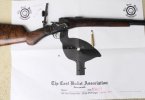Ian
Notorious member
So the Muzzeloader club I just joined added a BPCR competition to be held the day before each of their three annual matches, and I want to try it out for fun in June. Missed the last one because it wasn't advertised well and was a "gauging interest" and refining rules trial run, but it was quite successful and the next will probably be more so with more competitors.
I have only a little BPCR experience and only one qualifying rifle, a Shiloh 1874 Sharps in 45/90 WCF. Ranges are short, 100 and 200 yards, but the targets are tiny and many folks will be shooting 38/55s and other small, accurate chamberings. Position is cross sticks, any way you want, I think most will sit on armless chairs, stools, or benches.
Anyway, I need loading advise. As much as I love paper jackets I'll probably use lubricated cast bullets with a fiber card underneath. I read Venturino's book on shooting rhe buffalo rifles and learned very little. I have his and Garbe's SPG primer book and have not read it yet.
I have Lyman 45/90 dies, Lee 45/70 dies, a B&M powder measure, and 200 rounds of Starline nickel plated brass (all that was available 15 years ago). I have the Lyman Postell mould and the other one with the hemispherical nose, plus several others in the 350-400 grain range. I also have some aluminum arrow shafts and funnels to make a drop tube.
Where dies a fellow start?
I have only a little BPCR experience and only one qualifying rifle, a Shiloh 1874 Sharps in 45/90 WCF. Ranges are short, 100 and 200 yards, but the targets are tiny and many folks will be shooting 38/55s and other small, accurate chamberings. Position is cross sticks, any way you want, I think most will sit on armless chairs, stools, or benches.
Anyway, I need loading advise. As much as I love paper jackets I'll probably use lubricated cast bullets with a fiber card underneath. I read Venturino's book on shooting rhe buffalo rifles and learned very little. I have his and Garbe's SPG primer book and have not read it yet.
I have Lyman 45/90 dies, Lee 45/70 dies, a B&M powder measure, and 200 rounds of Starline nickel plated brass (all that was available 15 years ago). I have the Lyman Postell mould and the other one with the hemispherical nose, plus several others in the 350-400 grain range. I also have some aluminum arrow shafts and funnels to make a drop tube.
Where dies a fellow start?

